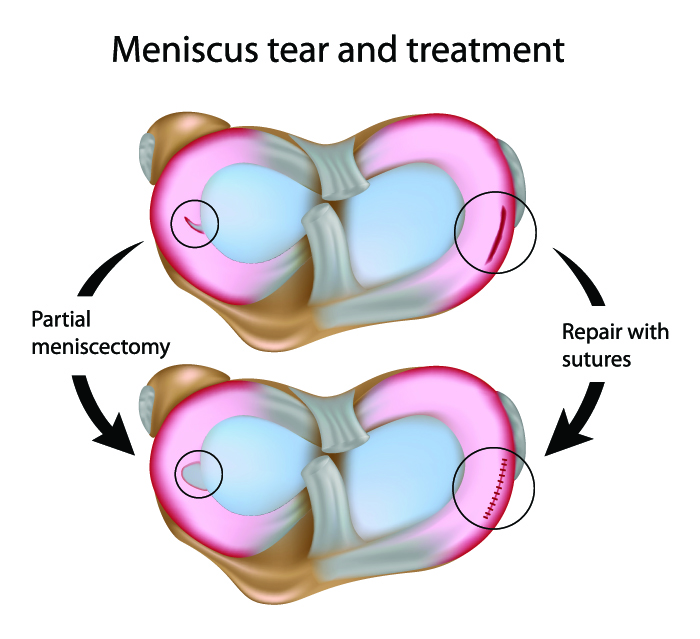Meniscus Repair Treatment & Diagnostics in Chunni Ganj, Kanpur
Meniscus Repair
The repairing of torn knee cartilage is done by the procedure known as arthroscopic meniscus repair. It is an outpatient surgical process. Meniscus repair is done by using minimally invasive surgery techniques and the success rate depends on the age of the tear, age of the patient, location and pattern, etc. After the operation physical therapy is a must for recovering and it may continue for 3-4 months after surgery. If the injury is not serious medications can help you recover and there is no need for undergoing surgery.

What are the symptoms of Torn Meniscus?
Pain and swelling in the knee joint are the common symptoms of torn knee cartilage. Pivoting motions, sudden movements, and putting excessive pressure on the affected area can increase the symptoms and worsening the condition. If a large torn meniscus fragment is caught in the knee joint then it can lock the knee and prevent motions.
Who can undergo Meniscus repair?
The recovery time required for meniscus repair is more. But if a meniscus is repairable it should be repaired as soon as possible. Some of the reasons for meniscus repair are as follows:
- When a patient is healthy and desires to stay active.
- The patient needs to understand and accept the risks involved in the process along with rehabilitation.
- The meniscus repair is possible if the tissue is in good condition or quality.
What surgical techniques are used in Meniscus Repair?
There are four types of surgical techniques by which meniscus repair in Kanpur can be performed. The following techniques are used:
- Open technique: This technique is useful for the preparation of the torn side. The issue with this technique is that only the peripheral of the tears is responsive and there is a risk of neural damage in this process. The open technique is not frequently used nowadays. In this process, an incision is made and a capsule is put further back inside the collateral ligament.
- Inside-out method: This technique is the most reliable because of the proven long-term results. A cannula with a self-delivery gun fitted to it is used to pass double-loaded sutures into the meniscus. In this method, the knots are tied outside the joint. This process also carries the risk of neurovascular problems.
- Outside-in method: This technique was introduced to reduce the risk of neurovascular issues. From the outside in a spinal needle is passed through the tear. The suture is passed by the ipsilateral portal once the sharp end of the needle is visible. Then the suture is pulled back after tying a knot. This process is repeated until all the free ends are tied.
- All-inside technique: An all-inside technique uses several devices such as tack, screws, and staples. This technique is used for repairing extreme root attachments or posterior horn tears. Most of these devices are made of rigid poly-L-lactic acid (PLLA). The all-inside technique has many advantages such as the low risk of a neurovascular problem, shorter surgery time, etc. The devices used in this process are RapidLoc, Meniscal Cinch, etc.
What are the risks involved?
The following are some of the complications that can occur:
- Infections.
- Hemarthrosis.
- Instrument failure.
- Ligament injury.
- Neurovascular issues.
- Fractures. Etc.
What are the benefits of the therapy?
Meniscus repair is done because of the following benefits and importance.
- Meniscus repair is done to reduce the pain and inflammation in the affected area.
- The control of the knee is improved by repairing the damaged area.
- The flexibility is restored by the therapy.
- Muscle restoration.
- The range of motion is also restored.
Conclusion
Meniscus repair helps to cure any torn ligaments by surgery or by medications. The techniques used nowadays are very safe but like all surgery, there are some complications present. To repair torn meniscus noninvasive methods are used. The recovery of such surgery depends on the severity of the tear and the patient’s age.
Request an appointment at Apollo Spectra Hospitals, Kanpur
Call 1860-500-2244 to book an appointment
Normally, it takes about 2-3 months to fully recover. Most patients can walk without any support after the recovery.
Pivoting motions, sudden movements, and putting excessive pressure on the affected area can increase the symptoms and worsening the condition. These are the few things that a patient should not do after the surgery.
The following are some of the exercises that you can do:
- Heel raise
- Quad sets
- Hamstring curls
Symptoms
Our Top Specialities
NOTICE BOARD
CONTACT US
CONTACT US
 Book Appointment
Book Appointment


.svg)
.svg)
.svg)
.svg)








